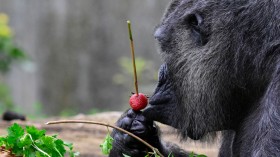No, you can't actually go and become a velociraptor trainer, like Hollywood actor Christ Pratt does in the new blockbuster "Jurassic World." However, you can certainly learn to be a 'raptor tracker.' In a new and intriguing study, paleontologist Scott Persons details how he and his colleagues have learned to follow 75-million-year-old dinosaur trails.
"Raptors are characterized by particularly nasty feet. Their big toes each bore an enlarged and wickedly hooked talon, which makes raptors well suited for Hollywood fight scenes," Persons, with the University of Alberta, explained in a recent statement.
According to the expert, it's these unique feet that make the velociraptor and other deinonychosaurs (commonly called "raptors") easier to identify and track, compared to most fossil trails and footprints.
"The enlarged raptorial claw was a killing tool. Raptors normally held it in a raised position," Persons said. "That way, the claw stayed sharp. Otherwise, it would have become dulled as it dug into the ground when the dinosaur walked. Modern cats retract their claws while walking or running for the same purpose." (Scroll to read on...)
The paleontologist recently had the opportunity to join his peers at a rich fossil site in central China, which contains the tracks of several kinds of dinosaurs, including raptors. There, researchers were able to pool their expertise to gain new insight into raptor locomotion - the results of which were recently published in the journal PaleoWorld.
Persons noted that they did find some exceptions to the raised-claw rule. While most raptor tracks only show the imprint of two whole toes and at-most the base of that third, they also found evidence that sometimes the raptors purposefully dug their deadly claw into the ground.
"One hypothesis is that, because the tracks were left in the soft mud of a lake shore, the raptors might have needed a little extra traction," he explained. "So, although the hooked claw was primarily a weapon, it could also be deployed like a big cleat."
For more great nature science stories and general news, please visit our sister site, Headlines and Global News (HNGN).
- follow Brian on Twitter @BS_ButNoBS
© 2024 NatureWorldNews.com All rights reserved. Do not reproduce without permission.

![Origin of Life: Discovery of Lava Being a Building Block of Life Hints 'Humans Have Volcanic Origins' [Study]](https://1471793142.rsc.cdn77.org/data/thumbs/full/70262/280/157/50/40/origin-of-life-discovery-of-lava-being-a-building-block-of-life-hints-humans-have-volcanic-origins-study.jpg)
![Great White Sharks Observed for the First Time Changing Their Behavior in Different Marine Environments [Study]](https://1471793142.rsc.cdn77.org/data/thumbs/full/70251/280/157/50/40/great-white-sharks-observed-for-the-first-time-changing-their-behavior-in-different-marine-environments-study.jpg)


